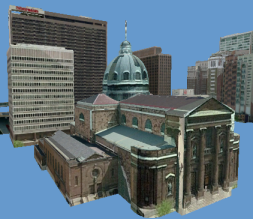Available with 3D Analyst license.
Multipatch data is stored in the geodatabase or shapefiles in the same manner as point, line, and polygon data. It can have attributes and be used with the standard tools, such as the Identify tool. However, its geometry type is unique to ArcGIS in that it can contain 3D models with vertical and overhanging faces. These faces may contain texture information, such as a digital photograph of the front of a building, allowing the creation of photorealistic 3D views.

Displaying multipatch data is, for the most part, the same process as displaying other geometry types. However, given its additional capabilities, there are many optimization techniques for multipatch data that you should be aware of when consuming it.
Multipatch geometries can also be stored in a style and used to symbolize point features. One effective use of this capability is to symbolize point features as trees or light poles within a 3D view.
Yet another way of consuming multipatches in a 3D view is to add them as 3D graphics. These 3D models are saved with the current 3D document rather than as features in a database.
Multipatches can also be edited in ArcGlobe as part of the 3D editing environment. Editing multipatch features is the same process as all other features types in ArcGlobe, ArcScene and ArcMap (2D). The 3D editing environment however offers more edit tool options specific to multipatches and functioning around a 3D view.
Learn more about editing multipatch features.
For more information behind what multipatch features are and how to create them, see Multipatches.